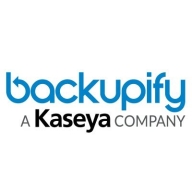

NetApp Cloud Volumes ONTAP and Backupify Google Workspace Backup compete in cloud storage and data protection. NetApp Cloud Volumes ONTAP has an advantage in data management flexibility and storage efficiency, while Backupify Google Workspace Backup stands out in integration with Google services.
Features: NetApp Cloud Volumes ONTAP offers robust data management tools, efficient storage utilization, and flexible cloud integration. Backupify Google Workspace Backup features automated data backup, quick recovery, and strong integration with Google Workspace for seamless functionality.
Ease of Deployment and Customer Service: NetApp Cloud Volumes ONTAP involves a complex deployment model but is supported by extensive technical documentation and professional support. Backupify Google Workspace Backup provides a straightforward deployment catered to Google Workspace environments, complemented by responsive customer service.
Pricing and ROI: NetApp Cloud Volumes ONTAP has a higher initial setup cost with promises of long-term ROI through efficient data management. Backupify Google Workspace Backup offers a lower entry cost, making it a cost-effective solution for small to medium enterprises focused on Google Workspace continuity.
| Product | Market Share (%) |
|---|---|
| NetApp Cloud Volumes ONTAP | 0.7% |
| Backupify Google Workspace Backup | 0.4% |
| Other | 98.9% |

| Company Size | Count |
|---|---|
| Small Business | 7 |
| Midsize Enterprise | 11 |
| Large Enterprise | 53 |
Backupify Google Workspace Backup provides essential data protection for Google Workspace users, ensuring continuity and security through comprehensive backup and restoration capabilities.
Designed to meet the needs of businesses relying on Google Workspace, Backupify Google Workspace Backup offers automated data protection, minimizing risks of data loss and ensuring compliance with industry standards. It supports seamless restoration functionalities, making it easier for IT administrators to manage and recover data efficiently, while also providing secure storage options to preserve data integrity.
What are the key features of Backupify Google Workspace Backup?In the healthcare sector, Backupify Google Workspace Backup ensures the protection of patient records, while in finance, it secures sensitive financial data, meeting specific industry compliance requirements. Schools use it to safeguard academic information, ensuring educational continuity and data availability.
NetApp Cloud Volumes ONTAP is an efficient storage management solution for managing and storing data in the cloud. It offers seamless integration with cloud providers, advanced data replication capabilities, and high data protection. With reliable performance, it is ideal for industries like healthcare and finance.
We monitor all Cloud Backup reviews to prevent fraudulent reviews and keep review quality high. We do not post reviews by company employees or direct competitors. We validate each review for authenticity via cross-reference with LinkedIn, and personal follow-up with the reviewer when necessary.